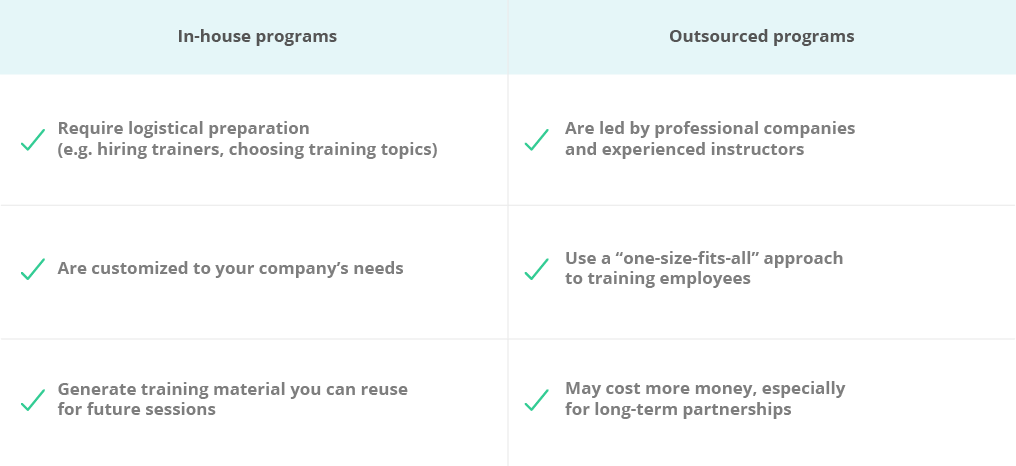How to Build an Employee Training Strategy

How to Build an Employee Training Strategy
Contributed ContentA directionless employee training strategy will hamper even the best business. This article provides a guide to creating a program tailored to your company’s needs.
Updated 03/15/2023
Employee training is essential in many ways. It helps improve employee engagement and increase retention. It can also increase the efficiency and productivity of your organization if done right.
However, it's important to remember that proper employee training is hard to come by. It requires a strategy that needs to be modern to serve your purpose. In other words, your employee training should be personalized.
A training strategy is built to achieve an educational goal in an organization. For example, employees must learn new skills or update them based on your company’s protocols.
Creating training strategies involves preparing your staff with an advanced skill set and setting them up for success within your organization. Common elements of training sessions include:
- Employee behavioral trainings, which can help you enhance the working standard of your organization. It will improve the respect between employees and create a friendly environment at your workplace.
- Leadership trainings, which can improve your employees’ management abilities.
- Peer training, which is used to give your employees a hands-on experience of new expertise. It can teach them about every relationship they can expect to have during their employment: client-to-client, service provider-to-service recipient, employee-to-employee, and upper management-to-lower management.
Employee training sessions can have long-lasting effects, for better or worse, so it is imperative that you dedicate the time necessary to crafting a professional training program that suits your company’s needs.
5 Steps to Institute a Purposeful Employee Training Program
A strong training plan will be key to meeting business needs including employee satisfaction, bettered company culture, and employee development opportunities. When you base decision-making on employee needs, you’re looking out for both your team members and your bottom line.
- Perform a training needs assessment
- Prepare a learning objective
- Design training materials
- Implement the training
- Evaluate the results
Connect with an HR consulting firm on The Manifest to firm up your employee training program.
Step 1: Perform a Training Needs Assessment
Arguably the most important part of this process is determining the current state of your employee training regimen. You must evaluate what you already do well and where you need to improve, both in terms of your training and your business as a whole.
To do so, a SWOT Analysis—sometimes called a SLOT Analysis—is a helpful guide as you determine your company’s:
- Strengths
- Weaknesses or Liabilities
- Opportunities
- Threats
A visual representation of this analysis can be found below:

Each quadrant above is designated for a specific part of the analysis:
- Strengths: List what your company already does better than your competitors. Part of your training strategy should be ensuring that you never lose this competitive edge.
- Weaknesses or Liabilities: Be honest with yourself about where your organization and employees could improve. Don’t be too overconfident; the more critical you are of yourself, the more you stand to gain from this exercise.
- Opportunities: Take hold of every opportunity that presents itself. Market trends and gaps are always present, so you need to identify them and improve the competency of your employees accordingly.
- Threats: Many external factors can threaten your business. You must be sure that your organization and employees are ready when they unexpectedly pop up.
Once you determine where you’re already succeeding and where you are the most at risk, you should easily be able to identify themes and action items to implement into your employee training methods.
Step 2: Prepare a Learning Objective
Before you begin any training program, you need to prepare a training objective.
A training program is useless without an understanding of what you are training employees to do.
You must identify a fundamental and clear business goal that the training supports. Don't provide training if it's not clear why you're doing it or if it doesn't directly reflect your business goals.
The ideal training objective should list:
- The employee’s skill set after completing the training
- The conditions in which the employee will perform their job
- The degree to which employees should be able to perform their assigned tasks
A product of of this exercise should be a collection of duties that your employees should be able to accomplish as a result of the training. Luckily, you should have already identified what skills your employees need during Step 1.
It’s worth reiterating that if the training has no direction or objective, it is of no use.
Step 3: Design Training Material
It's essential to have the right training materials in place before you rush into launching the training process. Below are a few points to keep in mind while creating training materials:
- The material should always focus on the learning needs of your employees.
- Always create your training content in a way directly relates to your learning objectives.
- Include as much hands-on practice as you can.
- Break your training material into small parts that can be easily understood.
- The content in the training material should be in an orderly manner.
- Try to interact with the employees as much as you can. Try to make them a part of the training.
- Try to include real-life examples in your training. It will increase people's interest.
All told, you must find different training activities that will help the employees grasp new skill sets.

Your itinerary should include at least a small introduction to a skill, a quick overview of the processing, and a demonstration with hands-on practice.
Step 4: Implement the Training Plan
Every step before now involved planning. This step is when you carry out the training strategy you have put together.
While doing so, be mindful of these tips:
- Inform your employees that a training is taking place. This may seem obvious, but you have to make sure that your employees will attend the meeting and take it seriously.
- You can use a Learning Management System (LMS) to keep track of the training and learning strategy. It can assign, deliver, track, and report the progress of the ongoing exercises, making the learning experience as accessible as possible for learners.
- Don’t forget the logistics: Inform the workers’ supervisors, arrange rooms for training, buy any necessary supplies, prepare a schedule, and consider providing food and drinks.
Your training can take shape in any number of ways, but it must be interactive so that it keeps everyone’s attention. It is not always possible to offer individual training, so you may need to identify the traits of a larger group and tailor your training accordingly.
There are many useful websites and books available on this topic that can help you execute a high-quality training session.
Step 5: Evaluate the Training
The training may be over, but your work isn’t.
Just as it was critical that you planned an effective session, it is similarly important that you determine how well it went.
You can base the success rate of the training on the following parameters and metrics:
- Employees’ reaction to the training: Their feedback regarding the training they just completed will be invaluable. You can collect this through an in-person debriefing or a printed or online survey, which can be found on various websites.
- Employees’ retention of the material: Obviously the training is no good if they don’t remember what they’ve just learned. It is important that you assess them based on the gap between their previous and improved skill set.
- Signs of training & development: For those undergoing training initiatives, tracking upskilling and the filling of skills gaps among employees is key to understanding how effective job training has been for stakeholders. This can most easily be evaluated during performance reviews, where in-house employee growth can be directly discussed and documented.
After putting in a lot of effort to plan and craft a meaningful employee training program, you will do yourself a disservice if you do not adequately measure its effects. Just as you had to be transparent regarding your company’s strengths and weaknesses, you must be able to honestly assess the quality of your training.
Your company and employees will suffer if you continue to roll out an ineffective training program, so you must be open to iterating and making changes as necessary. Even if you deem your training a success, it’s smart to always be on the lookout for ways to enhance it.
Better Training Means Better Employees
Employee training is likely necessary for your workplace regardless of industry.
With an effective model, your employees will be better-suited to tackling everyday tasks and unexpected issues with relative ease. They more prepared they are to handle the job’s complexities, the more fulfilled they will be while at work.
Happier and more competent employees are sure to result in greater customer service and more progress toward achieving your business goals.
Collaborate with an HR company on The Manifest to ensure your mentoring, onboarding, and training is up to par.
